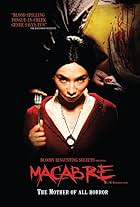The Indonesian society is seen through a middle-aged lady's eyes in her daily encounters with the street children who work and live off the harsh and sleazy world of adults.The Indonesian society is seen through a middle-aged lady's eyes in her daily encounters with the street children who work and live off the harsh and sleazy world of adults.The Indonesian society is seen through a middle-aged lady's eyes in her daily encounters with the street children who work and live off the harsh and sleazy world of adults.
- Awards
- 4 wins & 3 nominations total
Photos
- Director
- Writers
- All cast & crew
- Production, box office & more at IMDbPro
Featured reviews
This movie works for me because it depicts the plight of street children in Indonesia. We follow Asih's life as well as the street children's as they strive to live on a day to day basis. As I watched the movie, I sensed that its power lies in its ability to place us viewers with the children and how we are alarmed and delighted to find with them the worth of their lives in the streets. The children seemed all the more real to me because of how they faced violence, simple pleasures, elderly intrusions, cruel fate, life and death. A sad, moving, different and all too real movie.
This much-hyped, highly anticipated movie at its home turf was developed from a documentary video by the same director that was banned in the Soeharto-era Indonesia. It uses most of the real street kids from the documentary plus Indonesia's most respected veteran actress Christine Hakim. It opens beautifully promising even to surpass Garin Nugroho's hauntingly poetic 'Surat Untuk Bidadari' then wanders for about 20 minutes and losing its credibility towards the end. Garin Nugroho wallows in sentimentality and the film ends up being pretentious and silently preachy. The photography is beautiful but the plot is hopelessly brainless, it looks like the director tried to pad the film to its actually short running time. The street kids seem authentic for they are real but the acting is broad. Even Indonesian audiences will need subtitles because some of the dialogue are inaudible.
One can say that the movie is exploitative because it uses real street kids to do the glue-sniffing and their other dailies. Non-Indonesian audiences may find the movie exotically beautiful. (The film was the winner of 1998 Asian Pasific Film Festival in Taipei and won the jury prize in some film festival in Tokyo, Japan). But actually, it is not. Garin Nugroho can't do dialogue! (He used to make documentaries
One can say that the movie is exploitative because it uses real street kids to do the glue-sniffing and their other dailies. Non-Indonesian audiences may find the movie exotically beautiful. (The film was the winner of 1998 Asian Pasific Film Festival in Taipei and won the jury prize in some film festival in Tokyo, Japan). But actually, it is not. Garin Nugroho can't do dialogue! (He used to make documentaries
The streets of Yogjakarta in Central Java are occupied by homeless kids, attempting to survive the hopelessness of everyday life. The daily routines of three street kids are followed as they are slowly erased from the Earth's memory. Provoking stuff from a country swimming in poverty.
10PJ Cruz
"Leaf on a Pillow" reaffirmed my faith in the ability of South-East Asian film-makers. It is a grim, touching story about the plight of Indonesian street kids. The film depicts a society where livelihood is dependent on small businesses, and petty crime is a downright institution. In the mean streets of Yogyakarta, senseless violence is a GIVEN. <p> Watching this is a harrowing experience, from the opening scenes of a D-I-Y piercing, to the ultimate uncovering of a Government conspiracy. It's not quite as shocking as Tran Anh Hung's "Cyclo", but it's much more brutal in the way it deals with day-to-day injustices.
The director owes much to Scorsese. He uses rich, brown hues and dramatic lighting, creating a glum, rustic atmosphere, amidst the low-rent urban sprawl. You really feel for the homeless street children, and their aging, resilient den-mother.
"Leaf on a Pillow" is an example of simple, well-crafted narrative cinema. There is no hard-ass street lingo, or fancy slow-mo gunfights-- just great film-making.This movie brought a tear to my eye-- not very common, in an age of CGI and digital gimmickery.
The director owes much to Scorsese. He uses rich, brown hues and dramatic lighting, creating a glum, rustic atmosphere, amidst the low-rent urban sprawl. You really feel for the homeless street children, and their aging, resilient den-mother.
"Leaf on a Pillow" is an example of simple, well-crafted narrative cinema. There is no hard-ass street lingo, or fancy slow-mo gunfights-- just great film-making.This movie brought a tear to my eye-- not very common, in an age of CGI and digital gimmickery.
Authenticity is key in this piece, mirrored from its costume, art direction, cinematography and of course casting. From my opinion, 'Daun Di Atas Bantal' is a well balanced realism.
With intense performances by the real street children, it's only natural to feel like a documentary. Very composed and driven, the respectable Christine Hakim as 'Asih' (or perhaps derived from 'Kasih' which means love?), topped this fact and played just the right amount of mother and stranger to the children under her care to balance the overwhelmed documentary look.
Dialogues that sometimes seem vague and indistinct however works when holistically reviewed in retrospect, this film depicts realism at its more visually graphic nature than being dialogue-driven.
Life and death, living and barely surviving, are among the films' undoubtedly emotionally engaging issues that never fail to amuse especially non-Indonesians.
A well-deserved standing ovation for Christine Hakim and Garin Nugroho.
With intense performances by the real street children, it's only natural to feel like a documentary. Very composed and driven, the respectable Christine Hakim as 'Asih' (or perhaps derived from 'Kasih' which means love?), topped this fact and played just the right amount of mother and stranger to the children under her care to balance the overwhelmed documentary look.
Dialogues that sometimes seem vague and indistinct however works when holistically reviewed in retrospect, this film depicts realism at its more visually graphic nature than being dialogue-driven.
Life and death, living and barely surviving, are among the films' undoubtedly emotionally engaging issues that never fail to amuse especially non-Indonesians.
A well-deserved standing ovation for Christine Hakim and Garin Nugroho.
Did you know
- TriviaOfficial submission of Indonesia the 'Best Foreign Language Film' category of the 71st Academy Awards in 1999.
- GoofsSugeng's corpse's eyes move.
- ConnectionsFeatures Dongeng Kancil Untuk Kemerdekaan (1999)
Details
- Runtime1 hour 23 minutes
- Color
- Sound mix
Contribute to this page
Suggest an edit or add missing content














